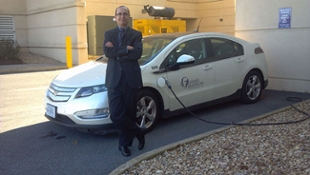How a JMU professor is filling the knowledge void about battery-powered cars
News Since Toyota started producing and selling its Prius model in 1997, millions of hybrid-electric vehicles — powered by gasoline and batteries — have been sold around the world.
Since Toyota started producing and selling its Prius model in 1997, millions of hybrid-electric vehicles — powered by gasoline and batteries — have been sold around the world.
Sales of all-electric vehicles — powered by batteries alone — lag far behind with a million sold around the world.
Dr. Matthew Eisler, a visiting assistant professor of integrated science and technology, says a lot still needs to be learned about all-electric vehicles, from performance to marketing to user experience, before they can become mainstream. "We know a lot about the technical parameters, the technical details of electric vehicles. What we don't know so much about is the user experience of the very latest battery electric vehicles, things like the Nissan Leaf and all the Tesla Motors vehicles, and how they age," said Eisler, who is writing a book about electric vehicle culture and economics.
One question Eisler is seeking to answer is how cars powered only by batteries change the way people drive. "Everyone is socialized to liquid fuel internal combustion auto mobility and everything that we do is based on that technology. So we have all kinds of habits and a lot of these habits you pretty much have to get rid of when you switch to all-battery electric vehicles."
One habit that will need at least some modification is the tradition of spontaneous, unplanned driving. Driving distances between fueling stops — at least for the next few years in vehicles costing less than $45,000 — is substantially shorter that what people are used to. Those cars generally go less than 100 miles per charge. For $75,000 or more, range is upwards of 200 miles between charges. Tesla Motors' goal is to produce a car costing less than $40,000 that can go 200 miles per charge by 2017-18.
"Everyone is socialized to liquid fuel internal combustion auto mobility and everything that we do is based on that technology. So we have all kinds of habits and a lot of these habits you pretty much have to get rid of when you switch to all-battery electric vehicles." — Dr. Matthew Eisler
But those miles per charge numbers are estimates. Actual miles per charge can vary depending on climate —extreme cold and heat can detract from battery performance— and people's driving styles. Moreover, little is known about how EV batteries age and depreciate, which is a big deal if users bear the cost of replacing spent batteries every few years or so, which can run into thousands of dollars.
The people driving all-battery powered vehicles now are providing important data for the next generation of battery vehicles. "In a sense they are informal engineers and they're subjecting these vehicles, and especially the batteries, to conditions you just cannot replicate in the lab environment unless you never want to sell anything and keep technology in testing for 20 years, and of course companies don't necessarily want to do that," said Eisler, whose research and teaching focus on the social context of science and technology.
In his research, Eisler has discovered a devout fan base for Tesla Motors vehicles, which he chronicled in a Nov. 17, 2015 article for The Conversation. But those owners are atypical, having the means to spend much more than the average car buyer and willing to put the their money down on a new technology that undoubtedly has some bugs.
While drivers of all-electric vehicles adapt to the new technology, auto manufacturers need to adapt their marketing, especially in California, where curtailing auto emissions is a big deal.
"Tesla focuses on torque and acceleration, and its true that BEVs can be astonishingly maneuverable, and fast when using the right battery, typically some version of lithium ion," Eisler said. But the reason people should value BEVs is "not so they can have maximum convenience and maximum performance and replicate the gasoline vehicle experience. The reason to value these vehicles is because they produce no emissions, at least at point of use. That is why the state of California has been pushing the technology."
For his book, which he plans to publish through MIT Press late this year, Eisler is interviewing drivers of battery-powered cars in California and in other parts of the U.S. where there are large communities of people driving battery-only vehicles, such as the Atlanta area and the northeast.
As for when electric vehicles will be considered mainstream, that depends on who you ask. "The Society for Automobile Engineers considers any vehicle that has an electric drive train, including a hybrid, to be an EV. So you could say the day of the mass-market commercial EV is already here, and has been since around 2006-2007, or so, in the form of the hybrid," Eisler said. "The enthusiasts and purists tend to consider the hybrid a nasty compromise, sort of a bridge to this ideal realm of the pure battery electric vehicle. But the chair of Toyota has said that is going to be a very long bridge."
By Rachel Petty ('17), JMU Public Affairs

